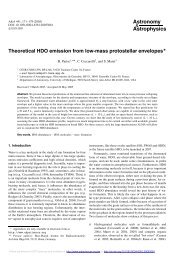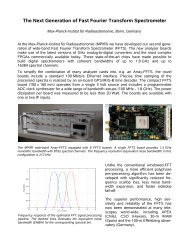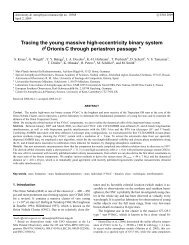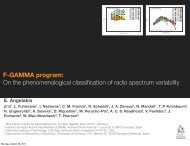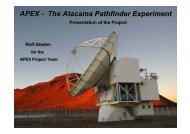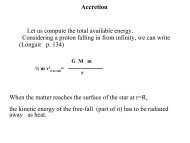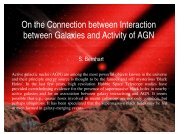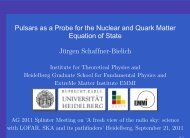Accretion disk with magnetic coronae in AGN
Accretion disk with magnetic coronae in AGN
Accretion disk with magnetic coronae in AGN
You also want an ePaper? Increase the reach of your titles
YUMPU automatically turns print PDFs into web optimized ePapers that Google loves.
2 Różańska et al.: Magnetic corona <strong>in</strong> <strong>AGN</strong><br />
The <strong>magnetic</strong>ally heated corona above an<br />
accretion <strong>disk</strong> is assumed to be <strong>in</strong> equipartition<br />
<strong>with</strong> the gas energy of the <strong>disk</strong> Liu et al.<br />
(2002). The hot corona is <strong>in</strong> thermal equilibrium,<br />
which means that heat<strong>in</strong>g via <strong>magnetic</strong><br />
field is balanced by cool<strong>in</strong>g via Compton scatter<strong>in</strong>g<br />
of both: the <strong>in</strong>tr<strong>in</strong>sic <strong>disk</strong> photons and<br />
the reprocessed radiation. The size of <strong>magnetic</strong><br />
loop is assumed to be constant and equal to<br />
10 R S chw Averaged density of the evaporat<strong>in</strong>g<br />
plasma is estimated from the energy balance at<br />
the <strong>disk</strong>/corona <strong>in</strong>terface.<br />
The coronal temperature, T, and the coronal<br />
density, n are calculated <strong>in</strong> the follow<strong>in</strong>g<br />
steps: i) for the given R and Ṁ we calculate<br />
the <strong>disk</strong> structure, ii) know<strong>in</strong>g P gas at the equatorial<br />
plane of the <strong>disk</strong> we derive strength of<br />
<strong>magnetic</strong> field B, iii) for the given B, and soft<br />
photons flux, F so f t , and from the conditions of<br />
energy equilibrium <strong>in</strong> the corona and at the<br />
<strong>disk</strong>/corona <strong>in</strong>terface, we calculate temperature<br />
and density.<br />
Such a solution depends on the fraction of<br />
the accretion energy dissipated <strong>in</strong> the corona,<br />
f cor , and <strong>in</strong>versely, there is a back reaction:<br />
the energy transfered from the <strong>disk</strong> to the<br />
corona by <strong>magnetic</strong> reconnection affects the<br />
<strong>disk</strong> structure.<br />
It was shown by Liu et al. (2002) that the<br />
ratio of energy dissipated <strong>in</strong> the corona to the<br />
total energy generated via accretion is proportional<br />
to the strength of <strong>magnetic</strong> field and<br />
Alfven speed:<br />
f cor = B2<br />
4π V A<br />
[ ( 3GMṀ<br />
1−<br />
8πR 3<br />
( RS<br />
) 1/2<br />
)] −1<br />
chw<br />
. (1)<br />
R<br />
The fraction of coronal energy is self consistently<br />
calculated by iteration of Eq.1 and solution<br />
of the <strong>disk</strong> structure. Note, that <strong>in</strong> the<br />
<strong>magnetic</strong> loops model only 1− f cor fraction of<br />
total angular momentum is carried by a <strong>disk</strong>.<br />
Contrarily to the accret<strong>in</strong>g corona model, <strong>magnetic</strong><br />
loops do not expla<strong>in</strong> how the fraction f cor<br />
of angular momentum is transfered outward.<br />
In case of <strong>magnetic</strong> loops, angular momentum<br />
transfer could be possible only when we additionally<br />
assume the existence of <strong>magnetic</strong>ally<br />
driven w<strong>in</strong>ds.<br />
Full results of those computations are presented<br />
<strong>in</strong> Różańska & Czerny (2005). For wide<br />
range of accretion rates <strong>disk</strong>s are dom<strong>in</strong>ated<br />
by radiation pressure, which is <strong>in</strong> contradiction<br />
<strong>with</strong> the analytical solution presented by<br />
Liu et al. (2002). In both considered cases i.e.:<br />
for Ṁ= 0.5Ṁ Edd and Ṁ=0.1Ṁ Edd , self consistent<br />
determ<strong>in</strong>ation of f cor is possible only<br />
for specific range of distances from the black<br />
hole (see: Fig. 2 and 3 <strong>in</strong> Różańska & Czerny<br />
(2005)). For the case of Ṁ= 0.5Ṁ Edd , corona<br />
extends up to 55 R S chw , for the Ṁ= 0.1Ṁ Edd ,<br />
up to 13 R S chw .<br />
3. Total spectrum from an accretion<br />
<strong>disk</strong> <strong>with</strong> <strong>magnetic</strong> corona<br />
The best test for our model is to calculate<br />
the total spectrum form an accretion<br />
<strong>disk</strong>/corona system which we present <strong>in</strong><br />
Fig.1. On each radius we assumed, follow<strong>in</strong>g<br />
Haardt & Maraschi (1991), than only half<br />
of radiation from corona is emitted as X-ray<br />
power-law. The second half illum<strong>in</strong>ates the<br />
<strong>disk</strong> and it is reprocessed and reemitted <strong>with</strong><br />
soft <strong>disk</strong> radiation. Compton amplification factor,<br />
A, for each radius depends only on the<br />
f cor , and <strong>disk</strong> albedo is assumed to be 0.15<br />
(Haardt & Maraschi 1991).<br />
The photon <strong>in</strong>dex on each radius is computed<br />
form Beloborodov (1999), us<strong>in</strong>g formula<br />
Γ= 7 3 (A−1)−1/10 . (2)<br />
The total spectrum is computed by <strong>in</strong>tegrat<strong>in</strong>g<br />
over <strong>disk</strong> radius: black body emission, from 3<br />
up to 10 5 R S chw , and corona power-law emission<br />
from 3 up to the extension of the corona.<br />
For both accretion rates we calculate the<br />
average ratio of X-ray to optical lum<strong>in</strong>osity<br />
(Zamorani et al. 1981), def<strong>in</strong>ed as:<br />
α ox = − log(l 2keV/l 2500Å )<br />
, (3)<br />
2.605<br />
where 2.605=log(ν 2keV /ν 2500Å ). For our models<br />
this <strong>in</strong>dex equals 1.99 for Ṁ = 0.5Ṁ Edd ,<br />
and 1.74 for Ṁ = 0.1Ṁ Edd . Typical observational<br />
values ofα ox for quasars span from 0.1<br />
up to 2 (Bechtold et al. 2003).



